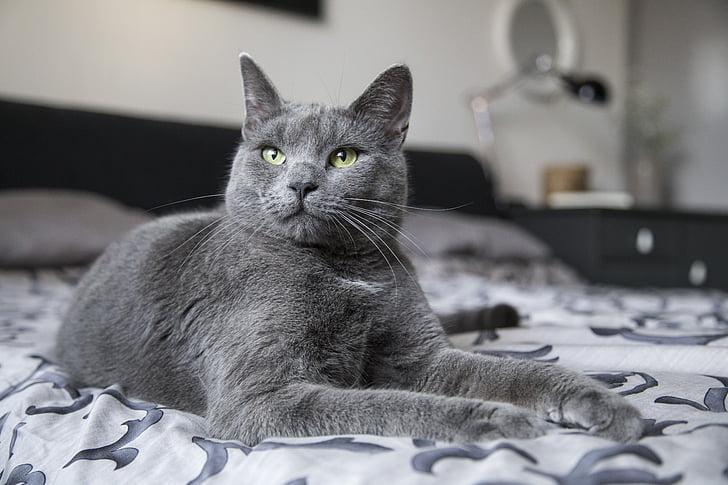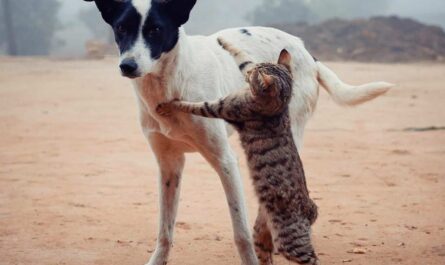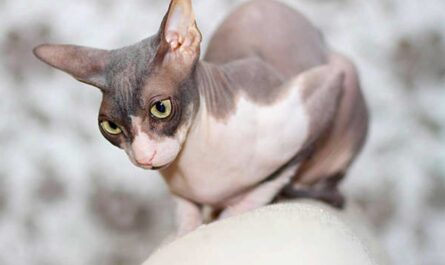Imagine this: Whiskers, your beloved feline companion, is about to give birth! Excitement fills the air as you anticipate the arrival of her adorable kittens. But what happens when the birthing process doesn’t go as planned? This is where dystocia, a term for difficult childbirth, comes in cat dystocia.
While the thought of complications might be nerve-wracking, here’s the good news: catching dystocia early and seeking veterinary attention can significantly improve the outcome for both mama cat and her precious kittens. This article will equip you with the knowledge to recognize the signs of dystocia, understand the normal birthing process in cats, and know when to seek professional help.
Throughout this guide, we’ll explore the key stages of feline pregnancy, delve into the birthing process, and highlight the crucial role of labor contractions. We’ll also discuss treatment options and offer resources for ensuring a smooth birthing experience for your furry friend.
So, take a deep breath, pet Whiskers reassuringly, and let’s navigate the wonderful world of feline pregnancy together. Remember, with knowledge and prompt action, you can play a vital role in supporting your cat during this special time.
When Delivery Goes Awry: Recognizing Dystocia
Giving birth is a natural and beautiful experience for most expecting feline mothers. However, sometimes complications can arise. Dystocia is a term used to describe the difficulty or inability of a cat to deliver her kittens without veterinary intervention. While uncommon, cat owners must be aware of the signs and symptoms of dystocia to ensure the health and well-being of both Mama Cat and her precious litter.
Understanding Dystocia: Different Types and Potential Causes
There are two main categories of dystocia: primary inertia and secondary inertia. Primary inertia refers to a situation where the mother cat doesn’t experience strong enough contractions to deliver the kittens, even though she’s in labor. This can be caused by a variety of factors, such as:
- First-time mothers: Young, inexperienced mothers might not have the hormonal surges necessary for strong contractions.
- Improper nutrition: A lack of essential nutrients in the mother’s diet can affect her ability to deliver.
- Uterine abnormalities: In rare cases, physical problems with the mother’s uterus can impede delivery.
Secondary inertia occurs when contractions initially begin but then weaken or stop altogether before all the kittens are delivered. This can be caused by:
- Fetal distress: If a kitten is experiencing health problems, it can stall the birthing process.
- Malpresentation: When kittens are not positioned head-first or tail-first for delivery, it can create an obstruction.
- Large litter size: A very large litter can overwhelm the mother’s ability to deliver naturally.
Warning Signs: When to Seek Help Immediately
While witnessing childbirth can be a heartwarming experience, it’s important to be observant and know when to seek veterinary help. Here are some critical signs of feline dystocia to watch for:
- Lethargy or excessive tiredness: A mama cat in labor might be tired, but extreme lethargy can indicate trouble.
- Straining for more than 30 minutes without delivering a kitten: Strong, consistent pushing is normal during labor, but prolonged straining without progress needs attention.
- Visible signs of distress: Excessive panting, yowling, or pacing can be signs that something is wrong.
- Abnormal vaginal discharge: A greenish or foul-smelling discharge can indicate infection.
- Visible signs of a kitten being stuck: If you see a paw or tail protruding for an extended period without further progress, seek help immediately.
Remember: Time is of the essence when dealing with dystocia. If you notice any of these signs, don’t hesitate to contact your veterinarian or take your cat to an emergency animal hospital. Early intervention can significantly improve the chances of a successful delivery and a healthy litter.
In the next section, we’ll explore treatment options for dystocia and how veterinary professionals can help your feline friend deliver her kittens safely.
Diagnosing and Treating Dystocia: Working with Your Veterinarian for a Positive Outcome
If you suspect your cat might be experiencing dystocia, seeking immediate veterinary attention is crucial. Here’s what to expect during the diagnosis and treatment process:
Veterinary Assessment: Unraveling the Cause
Your veterinarian will conduct a thorough examination to diagnose dystocia and determine the underlying cause. This might involve:
- Detailed History: The veterinarian will ask you detailed questions about your cat’s pregnancy, including her due date, any signs of labor observed, and the number of kittens already delivered (if any).
- Physical Examination: A gentle physical examination will be performed to assess your cat’s overall health, check for signs of fetal distress, and determine the position and size of the kittens.
- X-rays or Ultrasound: In some cases, X-rays or ultrasound might be recommended to visualize the number and positioning of the kittens within the uterus. This helps determine if a natural delivery is possible or if intervention is necessary.
- Blood Tests: Blood tests might be performed to check for any underlying health conditions that could be contributing to the dystocia.
By gathering this information, your veterinarian can create a tailored treatment plan to deliver the kittens safely and ensure your cat’s well-being.
Treatment Options: A Toolbox for Delivery
There are various treatment options for dystocia, depending on the specific cause and severity:
- Medical Management: In some cases, medication might be used to stimulate weak contractions or relax the cervix if it’s too constricted. This can help facilitate a natural delivery.
- Assisted Delivery: If the kittens are stuck in the birth canal due to their position or size, your veterinarian might carefully maneuver them manually to aid delivery. In some situations, specialized instruments might be necessary to assist with the process.
- Cesarean Section: If a natural delivery is deemed impossible or poses a risk to the mother or kittens, a cesarean section (C-section) might be the recommended course of action. This is a surgical procedure where an incision is made in the mother’s abdomen to deliver the kittens directly.
Remember: The goal is always to prioritize the health and safety of both the mother cat and her kittens. Your veterinarian will discuss the most appropriate treatment option with you based on the specific circumstances of your cat’s case.
The Importance of Owner Communication: Working Together for Success
Open communication with your veterinarian throughout the diagnosis and treatment process is vital. Here’s why:
- Sharing Information: Provide your veterinarian with as much information as possible about your cat’s pregnancy and any signs of dystocia you’ve observed.
- Asking Questions: Don’t hesitate to ask questions and voice any concerns you might have about the diagnosis or treatment plan.
- Understanding Options: Your veterinarian will explain the different treatment options available and discuss the risks and benefits of each procedure.
- Making Decisions: Ultimately, the decision regarding the best course of action rests with you. Your veterinarian will provide expert guidance and support you every step of the way.
By working together as a team with your veterinarian, you can increase the chances of a successful outcome for your cat and her precious kittens.
Here are some additional resources that you may find helpful:
- The American College of Veterinary Internal Medicine (ACVIM): https://www.acvim.org/
- The Cornell University College of Veterinary Medicine: https://www.vet.cornell.edu/
Remember, early intervention is key when it comes to dystocia. If you suspect your cat is having difficulty delivering her kittens, don’t wait – contact your veterinarian right away.
Nurturing Recovery: Post-Dystocia Care
While dystocia can be a stressful experience, with prompt veterinary intervention and proper aftercare, both mother cat and kittens can make a full and healthy recovery. Here’s what you can do to support your feline family during this crucial time:
Post-Partum Support: Helping Mom Cat Feel Her Best Again
Just like human mothers, cats need special care after giving birth. Following a dystocia case, providing additional support can help them recover physically and emotionally. Here’s how you can nurture the mama cat back to health:
- Pain Management: Your veterinarian might prescribe pain medication to help manage any discomfort your cat might be experiencing after delivery.
- Hydration is Key: Ensure your cat has easy access to fresh, clean water at all times. Dehydration is a potential concern after birth, so encourage her to drink by offering flavorful broths or using a pet fountain.
- Nourishing Meals: Provide high-quality kitten food or specially formulated post-partum cat food. These foods are rich in nutrients that will help your cat regain strength and produce nutritious milk for her kittens.
By offering a comfortable space, pain medication (as prescribed), plenty of fluids, and nourishing food, you’ll be creating the ideal environment for your cat to heal and bond with her newborn litter.
:max_bytes(150000):strip_icc()/how-to-tell-when-a-cat-is-ready-to-give-birth-1394646981-2000-592224c53d904aa5967692dd17cb3a4a.jpg)
Kitten Care: Nurturing the Next Generation
Those tiny bundles of fur may seem helpless, but they have essential needs too. Here’s how to ensure the well-being of the newborn kittens after a dystocia case:
- Warmth and Comfort: Newborn kittens are unable to regulate their body temperature. Create a warm, draft-free environment using a heating pad on a low setting (with a towel cover) or a hot water bottle wrapped in a blanket.
- Feeding Time: If the mother cat is unable to nurse her kittens due to dystocia complications, consult your veterinarian immediately. They can advise on alternative feeding methods using kitten formula and a feeding syringe.
- Keeping Things Clean: Keeping the nesting area clean and dry is crucial for preventing infections. Gently stimulate the kittens’ elimination by wiping their genitals with a warm, damp cloth after feedings (mimicking their mother’s grooming).
Remember, even if the mother cat can nurse her kittens, you might need to supplement their feedings if they seem weak or lethargic. Your veterinarian will be able to guide you on the appropriate feeding schedule and techniques.
Monitoring for Complications: Early Detection is Key
While most deliveries resolve without complications, it’s important to be aware of potential post-partum issues that might require veterinary attention. Here’s what to watch out for:
- Unusual Discharge: A foul-smelling vaginal discharge can be a sign of uterine infection.
- Lethargy or Loss of Appetite: If your cat seems unusually lethargic or loses her appetite after delivery, this could indicate an underlying health concern.
- Mastitis: Inflammation of the mammary glands (mastitis) can cause redness, swelling, and pain in the mammary tissue.
- Kitten Not Thriving: If a kitten appears weak, isn’t nursing well, or has difficulty gaining weight, consult your veterinarian promptly.
Early detection and treatment of any post-partum complications are essential for ensuring the health of both the mother cat and her kittens. If you notice any of these signs, don’t hesitate to contact your veterinarian for guidance.
Emotional Support: Understanding the Impact of Dystocia
Dystocia can be a stressful experience for both the cat and the owner. Here are some ways to provide emotional support during this time:
- Patience and Understanding: Your cat may be feeling overwhelmed and protective of her kittens. Be patient, handle them gently, and allow them the space they need to recover.
- Seeking Support: Talk to your veterinarian or a cat behaviorist if you’re feeling overwhelmed or need additional guidance on caring for your cat and kittens after dystocia.
- Celebrating Milestones: Despite the challenges, witnessing the bond between mother and kittens is a heartwarming experience. Take time to celebrate the little victories, like kittens gaining weight or successfully nursing.
By providing a nurturing environment, addressing their physical needs, and offering emotional support, you can help your feline family overcome the challenges of dystocia and create a foundation for a healthy and happy future together.
Mitigating the Risk: Preventive Measures for a Smooth Delivery
While dystocia can occur, there are steps you can take to increase the chances of your feline friend experiencing a smooth and successful delivery. Here are some proactive measures you can implement to create optimal conditions for a healthy birthing experience:
Pre-Natal Care: Planning for Parenthood
Just like human pregnancies, regular veterinary check-ups are crucial during your cat’s pregnancy. These prenatal visits allow your veterinarian to:
- Monitor Kitten Development: Through physical examinations and potentially ultrasounds, your veterinarian can assess the health and development of the kittens throughout pregnancy.
- Identify Potential Risks: Early detection of any potential health concerns in the mother cat or the developing kittens allows for prompt intervention if necessary.
- Discuss Birth Plan: Your veterinarian can discuss what to expect during delivery and answer any questions you might have about the birthing process.
Early intervention and a proactive approach can significantly reduce the risk of complications, including dystocia.
Proper Nutrition: Fueling Mom and Kittens
Just like us, pregnant cats need a well-balanced diet to ensure their own health and the healthy development of their kittens. Here’s what to keep in mind:
- High-Quality Cat Food: Opt for a high-quality kitten formula cat food specifically designed for pregnant and nursing cats. These formulas are typically higher in protein and calcium, essential nutrients for both mom and kittens.
- Meeting Nutritional Needs: The increased demands of pregnancy necessitate a higher calorie intake. Consult with your veterinarian to determine the appropriate amount of food to feed your pregnant cat to meet her nutritional needs without causing excessive weight gain.
- Fresh Water is Key: Ensure your cat has access to fresh, clean water at all times. Hydration is essential throughout pregnancy and lactation (nursing).
By providing a nutritious diet and ensuring proper hydration, you’re giving your cat the building blocks she needs for a healthy pregnancy and a successful delivery.
Maintaining a Healthy Weight: Finding the Purrfect Balance
A healthy weight is crucial for both mother and kittens during pregnancy. Here’s why:
- Easier Delivery: Maintaining a healthy weight throughout pregnancy can help to avoid complications during delivery. An overweight cat might have difficulty birthing naturally.
- Kitten Health: A mother cat’s weight can also impact the health of her developing kittens. Proper nutrition and weight management can help ensure the kittens develop properly.
Consult your veterinarian to determine your cat’s ideal weight during pregnancy and discuss a feeding plan that promotes healthy weight gain throughout this important stage. How AI, ChatGPT maximizes earnings of many people in minutes
Creating a Calm Environment: A Sanctuary for Birth
Giving birth is a vulnerable experience for any animal. Here’s how to create a stress-free birthing environment for your cat:
- Quiet and Private Space: Provide your cat with a quiet, secluded area away from the hustle and bustle of everyday life. This could be a spare room, a designated corner, or even a large cardboard box turned on its side.
- Familiar Surroundings: If possible, use familiar bedding or blankets from your cat’s usual sleeping spot to create a sense of security and comfort.
- Minimize Disruptions: Avoid disturbing your cat unnecessarily during labor and delivery. Keep an eye on things from a distance but allow her the privacy she needs to focus on giving birth.
By creating a calm and comfortable birthing environment, you can help your cat feel safe and secure during this important stage, promoting a smooth and successful delivery. Motivation – Mind – Success – Thinking – Productivity – Happiness
Beyond This Guide: Resources and Support
Giving birth can be a beautiful and natural experience for both mother cats and their owners. However, complications can sometimes arise. If you’re concerned about feline dystocia, here are some resources to equip you with further information and support:
Online Resources: A World of Knowledge at Your Fingertips
The internet offers a wealth of information on feline health and birthing. Here are some reputable sources to explore: Business – Money Making – Marketing – E-commerce
- The American Society for the Prevention of Cruelty to Animals (ASPCA): The ASPCA website provides a vast array of resources on cat care, including information on feline pregnancy, birthing, and potential complications. https://www.aspca.org/pet-care
- The Cornell University College of Veterinary Medicine: This website offers a feline health library with detailed articles on various cat health topics, including dystocia. https://www.vet.cornell.edu/
- The Spruce Pets: This user-friendly website provides comprehensive guides on all things pet-related, with informative articles on cat pregnancy and potential birthing difficulties. https://www.thesprucepets.com/
Remember: While online resources can be informative, they are not a substitute for professional veterinary advice.
Veterinarian Support: Your Trusted Partner in Cat Care
Your veterinarian is your most valuable resource when it comes to your cat’s health and well-being. Here’s why working closely with your vet is crucial: Health books, guides, exercises, habits, Diets, and more
- Personalized Guidance: Every cat is unique. Your veterinarian can provide personalized advice and support throughout your cat’s pregnancy, from pre-natal checkups to birthing guidance.
- Early Intervention: Early detection of potential problems is key. Regular veterinary checkups during pregnancy allow your vet to identify any risk factors for dystocia and create a birthing plan to ensure the best possible outcome for both mama cat and her kittens.
- Emergency Preparedness: Despite our best efforts, complications can sometimes arise during birth. Having a trusted veterinarian readily available is essential for prompt intervention if dystocia occurs.
Building a strong relationship with your veterinarian before your cat gets pregnant ensures you have a knowledgeable and experienced partner by your side throughout this special journey. Fitness – Meditation – Diet – Weight Loss – Healthy Living – Yoga
Breeder Networks: Breed-Specific Support
For certain cat breeds, there might be additional resources available through breeder organizations or experienced cat fanciers. Here’s how these networks can offer additional support:
- Breed-Specific Knowledge: Some breeds may have a higher predisposition for dystocia due to factors like head size or birthing canal conformation. Experienced breeders familiar with these breed-specific challenges can offer valuable insights and birthing advice. RPM 3.0 – 60% CONVERSION & Money for Affiliate Marketing
- Networking and Support: Connecting with other breeders who have experience with your cat’s particular breed can provide a sense of community and shared knowledge. They might be able to offer recommendations for reputable veterinarians experienced in birthing your specific breed.
Remember: Consulting with a veterinarian should always be your primary course of action, regardless of any breed-specific advice you might receive.
Final thought: A Supportive Birthing Journey
Feline dystocia can be a stressful experience, but it’s important to remember that veterinary medicine has made significant advancements in managing birthing complications. Early intervention and access to qualified veterinary care are crucial for a successful birthing experience. Cat accessories on Amazon
While dystocia is a possibility, countless cat mothers deliver healthy litters every year. Being aware of the signs and symptoms and having a birthing plan in place can significantly improve the outcome for both mama and kittens.
Empower yourself with knowledge, work closely with your veterinarian, and approach the birthing process with a positive and hopeful outlook. By being a well-informed and prepared cat owner, you can create a supportive environment for your feline companion to welcome her precious little ones into the world.
Other Interesting Articles
- How to Make Your Cat Really Happy: 29 Tips You May Try
- How to Train Your Cat to Stop Urine Marking? 12 Tips
- How Do Cats Communicate Each Other? 11 Body Language
- 24 Ways To Know If You Have An Extremely Happy Cat
- What Smells Do Cats Hate: 34 Scents You Must Avoid
- Everything You Need To Know About Cat Territory Marking
- 12 Reasons Why You Should Adopt A Second Cat
- 12 Reasons Cats Pee Outside the Litter Box: How To Solve
- 14 Reasons Why Cats Overgroom: Surefire Ways To Stop It
- Why is My Cat So Clingy? 13 Common Signs: 9 Caring Tips
- Is Your Cat Bored? 12 Common Signs: What You Can Do
- Stress in Cats: Causes, Symptoms, Remedies, Treatment
- 17 Common Signs Your Cat is Lonely: 10 Tips To Help Recover
- 14 Reasons My Cat is Acting Strange & Scared: What to Do?
- How Do Cats Hunt Their Prey, Mice, Bird, Fish, Rat For Food?
- How To Introduce A New Kitten To An Older Cat: 16 Tips
- 15 Reasons Why Do Cats Lick and Groom Each Other
- Domesticated Cats And Big Cats: 24 Similarities, Differences
- 21 Interesting Facts You Should Know About Feral Cats
- How to Socialize a Feral Kitten in 10 Simple Steps



